Creating a Culture of Feedback & Recognition [New Research]
Feedback is scary. But it doesn’t have to be. Building a culture of feedback connects employees back to their work and helps them feel valued for their contributions.
It’s more than just critiquing performance or a pat on the back. The benefit goes much further than the individual level. A culture of feedback leads to more engaged employees and an organization geared to employee success.
What does Quantum Workplace research say about employee feedback?
- Feedback improves engagement and retention.
- Employees want more feedback.
- Employees want meaningful feedback they can act on.
- Recognition is an important part of feedback.
Effective feedback improves employee engagement & retention
Feedback has a positive effect on employees’ engagement and retention. Research shows that when employees receive more frequent feedback, they’re 2X more engaged, 3X less likely to apply or seek other jobs, and 1.4X more likely to stay at your organization. This includes all types of feedback, whether it was from a manager or someone else in the organization.
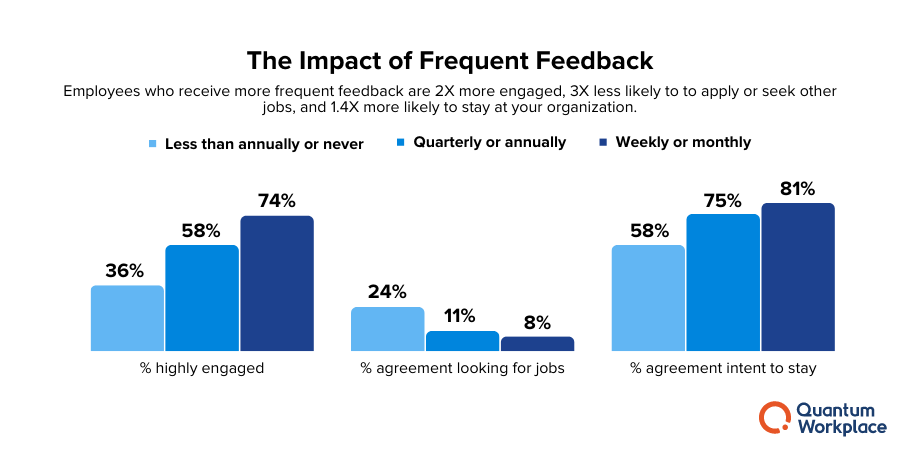
How do you connect feedback with engagement?
First, make sure everyone is getting the feedback they need. This includes the entire organization—from individual contributors to senior leadership. You also want to increase opportunities for feedback. Feedback should be part of 1-on-1 conversations, formal feedback processes and tools, and informal conversations.
Be sure to include employee recognition as part of feedback by reinforcing positive behaviors. You want to celebrate employee achievements and make sure to recognize managers too. Recognition (and any feedback) should be meaningful, clear, and specific.
Everyone wants more feedback
If you want to develop a culture of feedback, everyone needs to receive regular feedback. 46% of all employees say that they want more feedback about their work. That goes for employees at all levels. In fact, managers and senior leaders really want more feedback. And the person everyone wants feedback from the most is their manager.
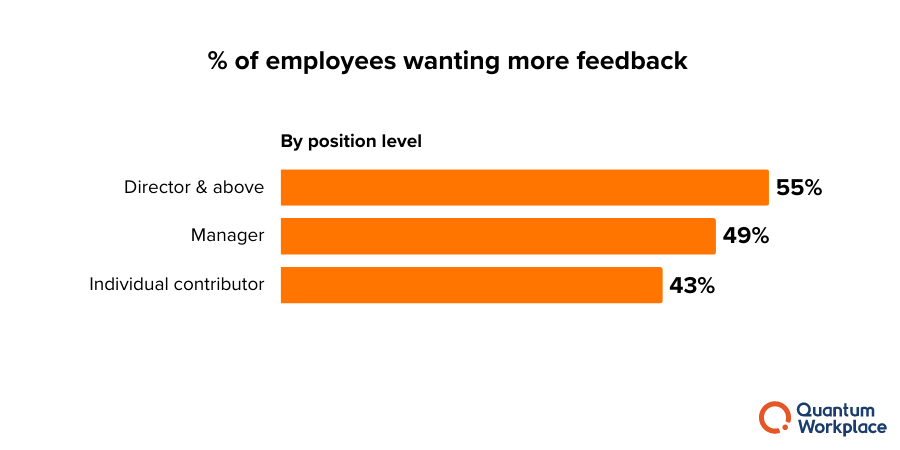
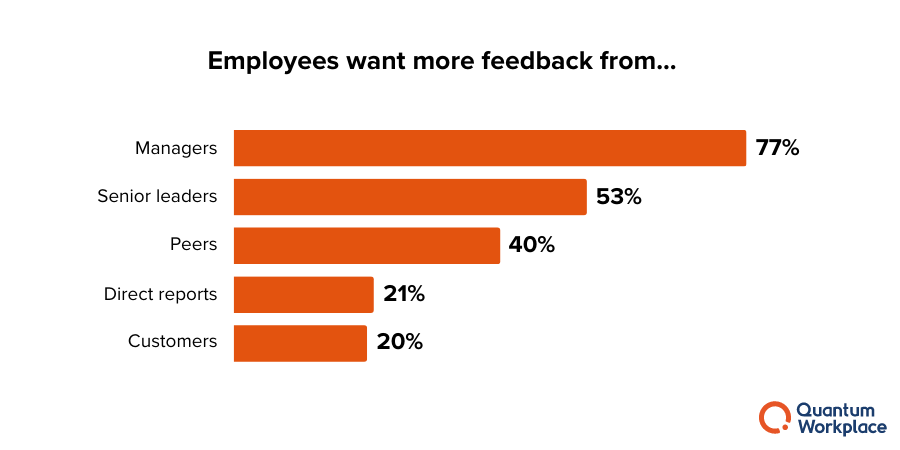
1 in 2 employees want more feedback. Those who receive less frequent feedback want more. Our research shows that 36% of employees who receive feedback monthly or weekly still want more.
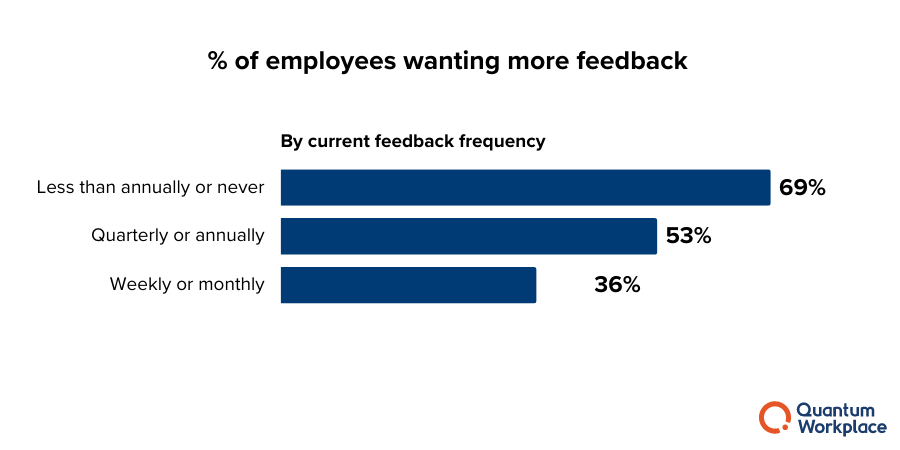
Employees may not ask for feedback, but that doesn’t mean they don’t want it. 1 in 5 employees has never asked for feedback. This could be because they haven’t been encouraged to ask for feedback. When building a culture of feedback, it’s important that everyone feels they are able to ask for feedback.
Workers in certain industries, like healthcare and industrial workers, are less likely to ask for feedback than their peers in other industries. Regardless of the industry, career level, or tenure with the organization, a culture of feedback reinforces the idea that everyone can ask for feedback and that feedback can help the organization move forward.
How do you increase feedback opportunities for everyone in the organization?
Start by asking for feedback.
Have managers ask for feedback from employees. Empower employees to request input from peers and managers. Asking for constructive advice and positive feedback helps build psychological safety and help everyone in the organization understand that feedback is a good thing and not to be feared.
Emphasize feedback for all.
Tell the organization. Individual contributors, managers, and senior leaders should all have a chance to receive frequent, meaningful feedback. By creating a culture of feedback, everyone in the organization understands that feedback is not only encouraged, it’s expected to make the organization better.
Increase feedback opportunities.
Feedback isn’t limited to a performance review. Create stronger alignment between managers and employees with continuous feedback throughout the year. Ramp up 1-on-1s to a weekly basis. Start with having employees ask the people they work closely with what is one thing they do well and one thing they could do better. Or use opportunities like 360-feedback.
Allow time for feedback.
Giving effective feedback is not intuitive for everyone. It often takes time to build that skill and cognitive effort to strike the right balance when giving feedback. Build in natural time periods when employees have time to both give and ask for feedback about their goals, their performance, and their collaboration.
Make feedback more meaningful
How you deliver feedback and recognition impacts employee motivation and how they respond. Both the feedback employees receive about their performance as well as the recognition they receive about their work impacts their engagement.
Delivery is never easy, so you have to concentrate on what matters most.
Research shows employees want to receive meaningful feedback for their contributions. Delivering on meaning means feedback should be clear, actionable, and performance focused. This helps employees stay motivated, act, and improve.
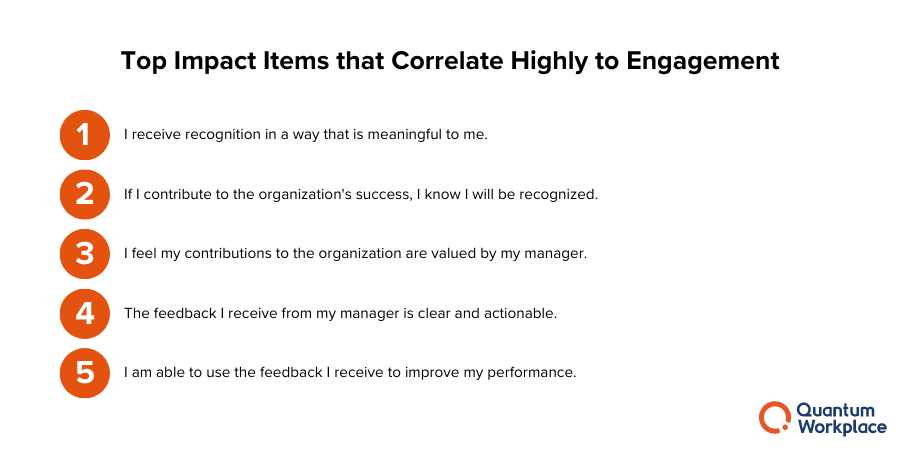
How do you provide meaningful feedback?
Be specific.
Showcase the impact of the person’s action. This helps employees understand how their work contributes to a team or organizational goal and further deepens engagement.
Coach managers.
Your managers should provide individualized, clear, and actionable feedback about performance. To get feedback right, be specific and use examples.
Avoid the feedback sandwich.
It’s tempting to give both constructive feedback as well as positive recognition. Some well-meaning managers tend to bury the constructive performance feedback between rounds of recognition – called the feedback sandwich. However, it is best to separate these two forms of feedback because people tend to focus on just the positive and ignore what they need to improve.
Recognition is a powerful feedback tool
Feedback is usually viewed as a negative. But recognition is an important form of feedback. It’s a powerful way to express appreciation and help employees feel valued that goes beyond acknowledging positive results, performance, or behaviors. It also signals to other employees what behaviors and performance standards are valued in the organization.
Right now, gaps exist with recognition.
Only 35% of employees receive recognition monthly or weekly. And 1 in 2 employees would like more recognition for their work. Employees who receive less frequent recognition want more, especially those who receive recognition less than monthly. All employees crave more recognition. Even managers! Everyone wants to be recognized for their performance and feel like a valuable member of the team and organization.
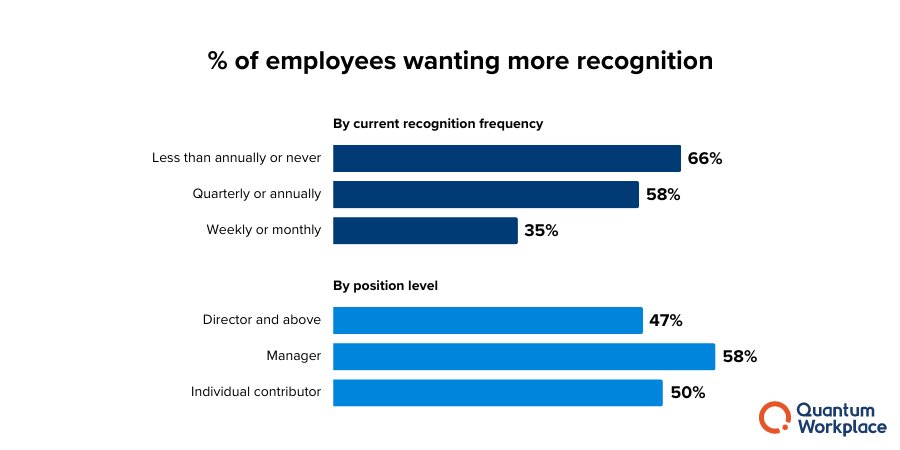
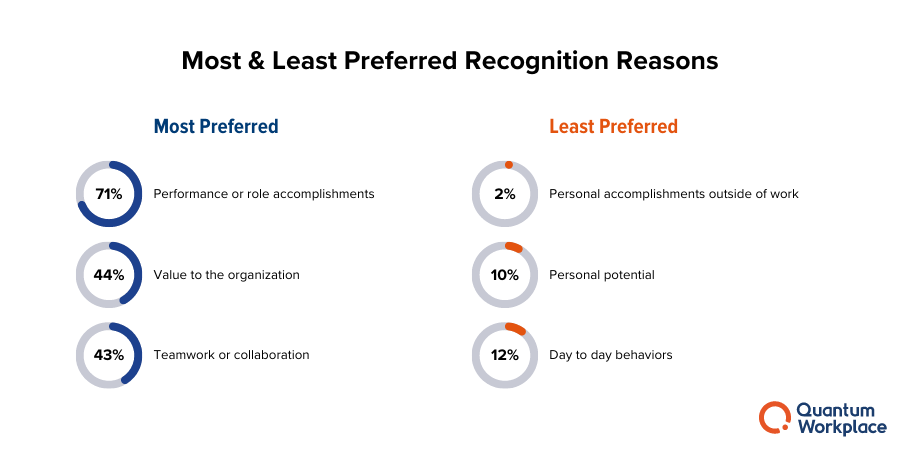
How do you improve recognition across the organization?
Be mindful of individual recognition preferences.
Not everyone likes to be called out in a group setting. Truly knowing your people helps you understand how they like to be recognized.
Make space for it.
Encourage leaders and managers to include recognition in 1-on-1s and team meetings. This will increase recognition frequency.
Recognize progress towards a performance or development goal.
By acknowledging effort and impact, you also illustrate how employee efforts contribute to the organization’s success.
Create a culture of recognition.
Employees want to be acknowledged for their contributions by managers, senior leaders, and peers.
Recognize your managers.
Yes, they play a significant role in giving recognition. But don’t leave them out. Everyone deserves recognition for good work.
10 tips for building a feedback culture
Designing a feedback culture isn’t something that just happens; it’s intentional. So how can you create a stronger feedback culture to improve employee performance? Here are 10 tips for building a feedback culture:
1. Nurture a growth mindset.
People with a growth mindset believe their abilities can be developed through dedication and hard work. They view their innate abilities as a starting point and have a love for learning.
Strong feedback cultures value this mindset. They value learning and development and view feedback as an opportunity to improve. And they don’t just say they value these things—they show it and integrate it into their business. Here are a few ways you can nurture the growth mindset in your organization:
Make it part of your hiring process. Is the candidate a lifelong learner? Do they independently pursue growth? How do they talk about and respond to failure?
Financially invest in growth. Offer an annual employee development allowance, provide access to internal and external learning opportunities, offer tuition reimbursement, or cover professional license or certificate costs for employees.
Recognize growing and getting better. Outputs aren't the only thing worthy of recognition. Regularly recognize employees when they're investing in their growth.
Lead with vulnerability. Strong leaders admit weaknesses and show willingness to take and learn from feedback. Be transparent about where the organization and leadership can improve.
2. Provide feedback training.
Both giving and receiving feedback are skills. Like any ability, they must be developed and practiced. To support a feedback culture, provide training and resources to your employees.
- Share how-tos on giving and receiving employee feedback
- Show videos or let employees observe examples of good and bad feedback interactions
- Train employees on how to communicate feedback effectively
- Help employees understand their resistance to feedback
- Train employees on asking questions, seeking examples, and clarifying meaning
- Develop manager skills in setting development goals for employees and help them achieve those goals
3. Set the tone from the top.
When employees see leaders model strong feedback principles, they're more likely to fall in line and do the same. Your leaders must hone their ability to give and receive feedback and set the example. They must consistently ask for feedback (up and down the hierarchy and sideways) and visibly show that they receive feedback well.
4. Create a feedback-safe environment.
Nurturing a feedback culture to work relies on one important factor: having employees who are willing to give honest feedback. Employees need to feel safe and know that if they give feedback they won’t face negative repercussions. This starts with building trusting relationships and is reinforced by how feedback is received.
Different employees will have different comfort levels with both giving and receiving feedback. It’s important to be respectful and not force feedback. Use emotional intelligence to gauge whether a person is ready to give or receive feedback, and if you can’t tell, ask.
5. Set clear expectations around feedback.
Create organizational standards for what feedback looks like and consistently convey that message to managers and employees. Set organizational expectations around your feedback structure. Address the following:
- Who gives feedback?
- Who receives it?
- How often does it occur?
- How do we do it?
- What is the goal of feedback?
6. Make it routine.
Practice makes perfect. When feedback happens routinely, it becomes expected. It integrates into everyday operations; and we get better at it.
Take Hudl for example. The sports technology company ingrained the idea of feedback into its culture with its value to be Respectfully Blunt, inspiring its own hashtag, #RealTalk. Hudl incorporates #RealTalk into everyday conversations among employees.
Culture is made up of shared traditions, habits, artifacts, and language. Look for opportunities to create these shared experiences around giving and receiving feedback. At Quantum Workplace, we participate annually in QW Voices, our employee survey and focus group initiative, and monthly in GOOD lunches, our manager-employee performance conversations.
7. Use different feedback channels.
A feedback culture doesn’t only have one way to give or receive feedback. People prefer to receive feedback in many ways, and different situations call for different feedback channels. By providing a variety of feedback channels, you give employees the opportunity to give feedback in a way that they’re most comfortable in different situations.
Consider what type of feedback would be most effective for the setting, giver, and receiver:
- Attributed vs. anonymous
- 1-on-1 vs. 360 feedback
- Individual vs. group
- Face-to-face vs. written
8. Nurture positive and corrective feedback.
Everyone loves positive feedback. But if you only focus on the good stuff, you risk ignoring problems and stagnating the growth of your employees. On the other hand, if you only focus on corrective feedback, you risk ignoring successes and undervaluing employee contributions.
Strike the right balance of positive and corrective feedback, and provide outlets for employees to give and receive both on a regular basis.
9. Highlight decisions made based on feedback.
When you make a decision or change based on someone’s feedback, let them know. Don’t only focus on communicating the decision or change; focus on the why. “Why did we do this? Because of your feedback.”
Feedback is a gift. If you don’t use it and appreciate the gift, you might not get another one. Having a feedback culture means that you actually respond and act on feedback. Employees need to see that giving feedback is worth their time. Don’t underestimate the value of following up on what you do with feedback.
10. Power your team with feedback tools.
Finally, be sure to power your team with employee feedback software. A technology partner can facilitate feedback processes by giving employees an easy way to record notes from feedback sessions, conduct two-way feedback conversations, request 360 feedback, give positive feedback via recognition, and collect feedback via surveys. This takes the administrative work out of feedback, allowing everyone to focus on growth.
Conclusion & About the Research
By creating a culture of effective feedback and recognition, you will also create an environment for employee success and business success.
This Quantum Workplace research is derived from the panel study titled: Feedback and Recognition at Work (n = 1,260 employees; February 2023). The Quantum Workplace Research Panel is a national opt-in sample derived from the Best Places to Work contest.
Learn more about the importance of feedback and other key 2024 employee engagement trends to help you drive employee success. View our 2024 Employee Engagement Trends Report.







